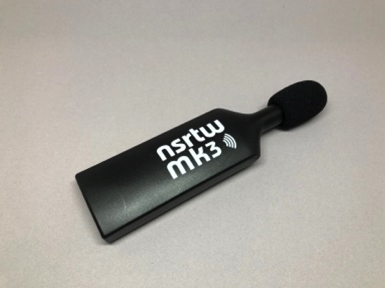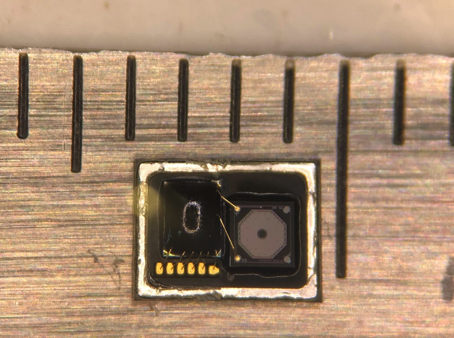
A measurement-class microphone such as a 0.5 in ICP microphone is typically a sizable part of the cost of a sound-level meter (SLM). That high instrument cost in turn constrains applications such as construction site monitoring or environmental studies, where many instruments are desired. Micro-electro-mechanical system (MEMS) microphones offer a high-performance alternative to traditional ICP microphones, at a cost that is at least two orders of magnitude lower. MEMS microphones have great qualities, mostly driven by the demands of the consumer-electronics market. However, they also have idiosyncrasies that need to be accounted for to design a high-quality SLM.
MEMS are electro-mechanical systems that are designed and manufactured using the same materials (usually silicon) and etching techniques used to make micro-circuits (see Figure 1). These techniques allow the creation of micron-scale structures with great precision and repeatability. MEMS microphones are extremely small, yet sensitive (the noise floor is usually better than 30 dBA). Many of them integrate amplification and digital sampling electronics at the chip level, thereby providing a digital signal directly and lowering the cost of the rest of the instrument.
 Figure 1: MEMS microphone next to 1 mm graduations. Source: Convergence Instruments |
The integration of analog-to-digital circuitry directly at the chip level also eliminates electro-magnetic noise that can be coupled to the analog input line in a traditional design.
MEMS microphones are manufactured using tightly controlled micro-etching processes, and, therefore, their characteristics are extremely consistent from one individual to the other. They are very linear (total harmonic distortion is 0.1% or better at 1 kHz/94 dB SPL) and they also have a very wide dynamic range (typically better than 30 dBA to 120 dBA). Additionally, MEMS microphones exhibit very little sensitivity to temperature changes. Likewise, their membrane is so small and light that they are more than 10 times less sensitive to vibrations than an electrostatic microphone. MEMS microphones are mass-produced for the consumer electronics market and are therefore very inexpensive. Their sensitivity is very stable over time. Usually requiring no recalibration to stay within the limits of the type I specification.
These advantages make MEMS microphones ideal candidates to be used in the design of SLMs. However, they also have some shortcomings that need to be corrected for, or at least understood to design an efficient SLM.
 Figure 2: Wireless SLM data logger. Source: Convergence Instruments |
Because they provide a digital signal at the chip-level, it is not possible to remove the pressure-sensitive capsule from the rest of the circuitry and test the analog chain alone. All relevant SLM standards were written in the 1970s and assume that the SLM design consists of a separate microphone capsule, driving an analog processing chain, or an analog-to-digital converter (ADC) followed by a digital processing chain. They mandate the testing of the SLM using electrical signals in place of the microphone. This is not possible when the analog-to-digital conversion is done in the microphone itself, at the chip level. This means that even though an SLM may have the performance required to comply with a certain standard, it cannot be tested using the methodology prescribed by that standard.
Because of the extremely small size of the silicon structures, even very small dust particles can easily damage them. Very high static and dynamic pressures (typically above 160 dB-SPL) can also cause damage to those small silicon structures.
MEMS microphones generally have a sharp resonance in the 10 kHz to 20 kHz range. That resonance needs to be corrected for so that the frequency response of the SLM falls within the limit lines of the appropriate standards.
Some of the shortcomings described above need to be countered to design and manufacture an efficient SLM. The most important factor is making sure that the frequency response is flat relative to the specified theoretical weighted response (dB-A, dB-C or dB-Z). The high-frequency resonance of a MEMS microphone has a slightly different frequency and damping from one individual to the other. Therefore, it is important to precisely measure that resonance and optimize a correction filter to flatten the response. During the production process, Convergence Instruments uses adaptive filter techniques to identify and optimize the correction filter for each weighting factor.
 Figure 3: Response error of an uncorrected MEMS microphone, relative to the theoretical dB-C response. Source: Convergence Instruments |
This operation is completely automated and takes 30 seconds per instrument. Figures 3, 4 and 5 show the error relative to the theoretical dB-C response for the uncorrected microphone, and for the microphone after corrective filtering. There are two options for the corrected response.
Method 1: As a standard practice, the response is made flat between 20 Hz and 10 kHz. Above 10 kHz, it is made to follow precisely the center-point between the two limit lines of IEC61672-2002 type I. This provides the best margin for compliance to that standard (see Figure 4).
 Figure 4: Response error after correction for the dB-C weighting factor (Method 1). Source: Convergence Instruments |
Method 2: As a special request, Convergence Instruments can also flatten the response up to 20 kHz (see Figure 5).
 Figure 5: Response error after correction for the dB-C weighting factor (Method 2). Source: Convergence Instruments |
The sensitivity to dust can be countered using an ePTFE membrane. These membranes have a porosity so fine that they will not let any dust or even water enter the microphone cavity. The best ePTFE membranes made for MEMS microphones have an attenuation of around 1 dB, with a slight frequency-dependence. The calibration and frequency correction are done after the membrane is placed over the microphone, and therefore takes its frequency-dependence into account.
Damage to the microphone due to static or dynamic over pressure cannot be countered. Therefore, the user must be mindful of that vulnerability. MEMS microphones have pressure equalization holes designed in the silicon structure. But to pass low frequencies, the time constant of the pressure equalization is long. That means that rapid pressure changes can damage the microphone. A classic situation leading to over-pressure is when the microphone is inserted into a calibrator. A 160 dB-SPL absolute maximum pressure limit translates into only 0.02 atmosphere of pressure. It is not difficult to reach the absolute maximum limit simply by inserting the microphone into a calibrator. Insertion into (and removal from) a calibrator must be done as slowly as possible to give the microphone the best chance to equalize the pressure and avoid damage to the plates. It is also important to note that MEMS microphones are not the best options to measure high-pressure acoustic pulses, such as explosions or gun fire. In such applications, the user must make sure that the peak pressure at the location of measurement does not reach the absolute maximum pressure level.
Since they are designed and manufactured for the consumer market, MEMS microphones offer a high-quality signal at low cost. MEMS manufacturing techniques ensure a high consistency of their parameters from one microphone to another. They are extremely stable over time and temperature. Their high-frequency resonance must be counteracted precisely to get a spectral sensitivity that is accurate enough for a type I SLM. This requires advanced signal processing techniques. However, given the high-computational power of today’s processors, this does not add significantly to the cost of the instrument.
Given the pressure that the consumer market keeps applying to the industry, the quality of signal offered by MEMS microphones is constantly improving. Convergence Instruments expect that the use of MEMS microphones in sound measurement applications will keep growing for the foreseeable future.
Convergence Instruments 2024 © All Rights Reserved | Privacy Policy and User Agreement | Terms and Conditions | Limited Warranty